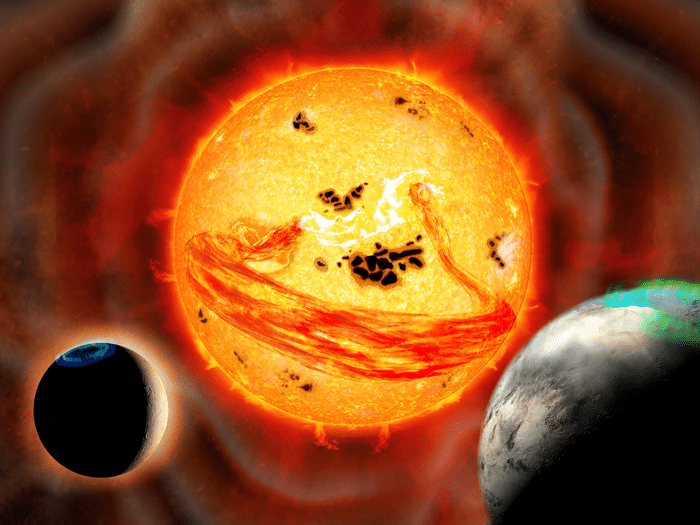If something nefarious were going to occur in the universe, it seems appropriate that it would come from a star named EK Draconis in the constellation Draco. That seems to be exactly what happened 111 light-years away from Earth last year when the distant star was observed to have ejected a massive burst of energy, charging particles much more powerfully than scientists have ever observed from a Sun-like star.
A study from a research group led by Kosuke Namekata and Hiroyuki Maehara at the National Astronomical Observatory of Japan (NAOJ) has been observing the young solar-type star using several satellites and telescopes, including the 3.8-meter Seimei Telescope in western Japan and NASA’s Transiting Exoplanet Survey Satellite (TESS). The researchers observed EK Draconis for 32 nights in the winter and spring of 2020. On April 5, the team got lucky as they looked on while the star erupted.
What they observed was a superflare the size of which could scorch our own Sun’s orbiting planets if something similar currently happened in the solar system. In their study, the researchers found evidence of a coronal mass ejection, an eruption of a supermassive filament of plasma gas so hot that it breaks down into ions and electrons. This filament was large too, ten times more massive than any mass ejection ever recorded on the Sun. The monster ejection was caught speeding at 500 km / sec (roughly a million miles per hour).
“Coronal mass ejections can have a serious impact on Earth and human society,” said Yuta Notsu, a research associate at the Laboratory for Atmospheric and Space Physics at Colorado University, Boulder, and the U.S. National Solar Observatory, who worked on the project. “This kind of big mass ejection could, theoretically, also occur on our sun. This observation may help us to better understand how similar events may have affected Earth and even Mars over billions of years.”
Coronal mass ejections often come right after a star lets loose a flare, or a sudden and bright burst of radiation that can extend far out into space. Recent research has suggested that on our Sun, this sequence of events may be relatively sedate, at least so far as scientists have observed. In 2019, for example, Notsu and his colleagues published a study that showed that young sun-like stars around the galaxy seem to experience frequent superflares — like our own solar flares but tens or even hundreds of times more powerful. Technically, this type of superflare could happen here, but isn’t something that should keep one up at night. Such an event might happen maybe once every several thousand years or so.
The researchers believe that such hot, high-speed filaments most likely happen in younger stars. In fact, if such a thing happened in our solar system during its infant years, it could have helped shape Earth and Mars into what they look like today.
“The atmosphere of present-day Mars is very thin compared to Earth’s,” Notsu said. “In the past, we think that Mars had a much thicker atmosphere. Coronal mass ejections may help us to understand what happened to the planet over billions of years.”










